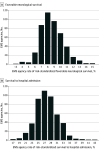Emergency Medical Service Agency Practices and Cardiac Arrest Survival
- PMID: 38837166
- PMCID: PMC11154368
- DOI: 10.1001/jamacardio.2024.1189
Emergency Medical Service Agency Practices and Cardiac Arrest Survival
Abstract
Importance: Survival for out-of-hospital cardiac arrest (OHCA) varies widely across emergency medical service (EMS) agencies in the US. However, little is known about which EMS practices are associated with higher agency-level survival.
Objective: To identify resuscitation practices associated with favorable neurological survival for OHCA at EMS agencies.
Design, setting, and participants: This cohort study surveyed EMS agencies participating in the Cardiac Arrest Registry to Enhance Survival (CARES) with 10 or more OHCAs annually during January 2015 to December 2019; data analyses were performed from April to October 2023.
Exposure: Survey of resuscitation practices at EMS agencies.
Main outcomes and measures: Risk-standardized rates of favorable neurological survival for OHCA at each EMS agency were estimated using hierarchical logistic regression. Multivariable linear regression then examined the association of EMS practices with rates of risk-standardized favorable neurological survival.
Results: Of 577 eligible EMS agencies, 470 agencies (81.5%) completed the survey. The mean (SD) rate of risk-standardized favorable neurological survival was 8.1% (1.8%). A total of 7 EMS practices across 3 domains (training, cardiopulmonary resuscitation [CPR], and transport) were associated with higher rates of risk-standardized favorable neurological survival. EMS agencies with higher favorable neurological survival rates were more likely to use simulation to assess CPR competency (β = 0.54; P = .05), perform frequent reassessment (at least once every 6 months) of CPR competency in new staff (β = 0.51; P = .04), use full multiperson scenario simulation for ongoing skills training (β = 0.48; P = .01), perform simulation training at least every 6 months (β = 0.63; P < .001), and conduct training in the use of mechanical CPR devices at least once annually (β = 0.43; P = .04). EMS agencies with higher risk-standardized favorable neurological survival were also more likely to use CPR feedback devices (β = 0.58; P = .007) and to transport patients to a designated cardiac arrest or ST-segment elevation myocardial infarction receiving center (β = 0.57; P = .003). Adoption of more than half (≥4) of the 7 practices was more common at EMS agencies in the highest quartile of favorable neurological survival rates (70 of 118 agencies [59.3%]) vs the lowest quartile (42 of 118 agencies [35.6%]) (P < .001).
Conclusions and relevance: In a national registry for OHCA, 7 practices associated with higher rates of favorable neurological survival were identified at EMS agencies. Given wide variability in neurological survival across EMS agencies, these findings provide initial insights into EMS practices associated with top-performing EMS agencies in OHCA survival. Future studies are needed to validate these findings and identify best practices for EMS agencies.
Conflict of interest statement
Figures

Similar articles
-
Out-of-hospital cardiac arrest surveillance --- Cardiac Arrest Registry to Enhance Survival (CARES), United States, October 1, 2005--December 31, 2010.MMWR Surveill Summ. 2011 Jul 29;60(8):1-19. MMWR Surveill Summ. 2011. PMID: 21796098
-
Resuscitation Practices at Emergency Medical Service Agencies Working in Black and Hispanic Versus White Catchment Areas in the United States.Circ Cardiovasc Qual Outcomes. 2025 Jun;18(6):e011799. doi: 10.1161/CIRCOUTCOMES.124.011799. Epub 2025 May 30. Circ Cardiovasc Qual Outcomes. 2025. PMID: 40444347
-
Cardiac Arrest Survival at Emergency Medical Service Agencies in Catchment Areas With Primarily Black and Hispanic Populations.JAMA Intern Med. 2023 Oct 1;183(10):1136-1143. doi: 10.1001/jamainternmed.2023.4303. JAMA Intern Med. 2023. PMID: 37669067 Free PMC article.
-
Community first responders for out-of-hospital cardiac arrest in adults and children.Cochrane Database Syst Rev. 2019 Jul 19;7(7):CD012764. doi: 10.1002/14651858.CD012764.pub2. Cochrane Database Syst Rev. 2019. PMID: 31323120 Free PMC article.
-
When is a Cardiac Arrest Non-Cardiac?Prehosp Disaster Med. 2017 Oct;32(5):523-527. doi: 10.1017/S1049023X17006446. Epub 2017 May 2. Prehosp Disaster Med. 2017. PMID: 28463098 Review.
Cited by
-
Sudden cardiac arrest mortality in China: temporal trends and risk factors.Mil Med Res. 2025 Aug 15;12(1):49. doi: 10.1186/s40779-025-00639-7. Mil Med Res. 2025. PMID: 40813723 Free PMC article.
-
Rurality and Area Deprivation and Outcomes After Out-of-Hospital Cardiac Arrest.JAMA Netw Open. 2025 Apr 1;8(4):e253435. doi: 10.1001/jamanetworkopen.2025.3435. JAMA Netw Open. 2025. PMID: 40232722 Free PMC article.
References
MeSH terms
LinkOut - more resources
Full Text Sources
Medical
Miscellaneous

